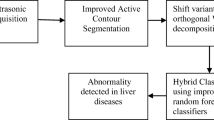Abstract
The use of digital images has increased and great strides have been made in the area of forensic science, pathology and other technological discoveries, there is a great need for computational and forensic techniques capable of detecting objects in images for the purpose of criminal investigation through classification, regression and quantifying objects to establish linkages, associations, and reconstructions. This paper presents extremely randomized tree algorithm for weapons classification using ultrasound images of the wounds caused by stabbing with sharp metals, these ultrasound images describe the internal structure of the wounds with patterns which helps us in determining weapon used for stabbing in most of the homicidal cases. The proposed method uses ultrasound images as input, enhanced with preprocessing techniques and segmentation for the region of interest, the segmented image is used for extracting features such as texture, shape, and size of the wounds that will be data for extremely randomized trees algorithm. The methodology is trained and tested on the available database of 300 images, through a number of testing; the efficiency of the proposed methodology is tested rigorously. The testing results show that aside from exceptional cases, the classification methods are able to correctly determine with an average accuracy of 95.95%. Not many researchers worked on the said problem statement with the computational approach but the proposed method as compared to a traditional method in which recognition is by human verification manually, it is found that the proposed work has given higher accuracy results with the set of features selected for identification and classification.





Similar content being viewed by others
References
Brandon Westover, M., O’Sullivan, Joseph A.: Achievable rates for pattern identification. IEEE. Trans. Inf. Theory. 54(1), 299–320 (2008)
Jie, L., Jigui, S., Shengsheng, W.: Pattern identification: an overview. Int. J. Comput. Sci. Netw. Security. 6(6), 57–61 (2006)
Kaliszan, M., et al.: Striated abrasions from a knife with a non-serrated blade—identification of the instrument of crime. Int. J. Legal. Med. 125(5), 745–748 (2011)
Li, D.: Firearm identification system based on ballistics image processing. In: Proceedings of CISP ‘08, Congress on image and signal processing, vol. 3, pp. 149–154 (2008)
Louis, W., Damien, E., Pierre, G.: Ensembles of extremely randomized trees and some generic applications. In: RTE-VT workshop, Paris, May 29–30 (2006)
Mohafez, H., et al.: High-frequency ultrasound imaging in wound assessment: current perspectives. Pertanika J Sci Technol 25(4), 1039–1050 (2017)
Offiah, C., Hall, E.: Imaging assessment of penetrating injury of the neck and face. Insights. Imaging. 3(5), 419–431 (2012)
Song B.: Automated wound identification system based on image segmentation and artificial neural networks. In: IEEE International Conference on Bioinformatics and Biomedicine, 4–7 Oct, pp: 11–16, (2012)
Gitto, L., Vullo, A., Demari, G.M.: Identification of the murder weapon by the analysis of a typical pattern of sharp force injury. Ital. J. Legal. Med. 1(1), 04–14 (2012)
Ying, B., Dali, W.: Evaluate and identify optimal weapon systems using fuzzy multiple criteria decision making. In: Proceedings of IEEE International Conference on Fuzzy Systems, 27–30 Jun, pp: 1510–1515, (2011)
Suapang, P., et.al.: Tool and firearm identification system based on image processing. In: Proceedings of 11th International Conference on Control, Automation and Systems, 26–29 Oct, pp: 178–182, (2011)
Francisco, V., et al.: Binary tissue classification on wound images with neural networks and Bayesian classifiers. IEEE. Trans. Med. Imaging. 29(2), 410–426 (2010)
Anil, J., Jung-Eun, L.: Scars, marks, and tattoos: a soft biometric for identifying suspects and victims. In: SPIE, the international society for optics and photonics National Symposium, (2009)
Plattner, T., et al.: Gunshot residue patterns on skin in angled-contact and near contact gunshot wounds. Forensic. Sci. Int. 138(1), 68–74 (2003)
Coyle, I.R., Filed, D., Wenderoth, P.: Pattern recognition and forensic identification: the presumption of scientific accuracy and other falsehoods. Criminal. Law. J. 33(4), 214–226 (2009)
Wang, D.: A multiscale gradient algorithm for image segmentation using watersheds. Pattern. Recognit. 30(12), 2043–2052 (1997)
Shuaibur Rahman, Khan, M.N.A.: Digital forensics through application behavior analysis. Int. J. Mod. Educ. Comput. Sci. 8(6), 50–56 (2016)
Andaló, F.A., Miranda, A.V., Falcão, A.X.: Shape feature extraction and description based on the tensor scale. J. Pattern. Identif. 43(1), 26–36 (2009)
Li, Qi Peter, Juang, Biing-Hwang: Study of a fast-discriminative training algorithm for pattern identification. IEEE Trans. Neural. Netw. 17(5), 1212–1221 (2006)
Savakar, Dayanand G., Kannur, Anil: A Genetic algorithm and Bayesian approach for identification and classification of weapon based on the stab wound patterns caused by different sharp metal. Int. J. Comput. Eng. Appl. 9(1), 01–12 (2015)
Author information
Authors and Affiliations
Corresponding author
Additional information
Publisher’s Note
Springer Nature remains neutral with regard to jurisdictional claims in published maps and institutional affiliations.
Rights and permissions
About this article
Cite this article
Savakar, D.G., Kannur, A. An extremely randomized trees method for weapons classification based on wound patterns of sharp metals using ultrasound images. Iran J Comput Sci 2, 207–217 (2019). https://doi.org/10.1007/s42044-019-00036-z
Received:
Accepted:
Published:
Issue Date:
DOI: https://doi.org/10.1007/s42044-019-00036-z




